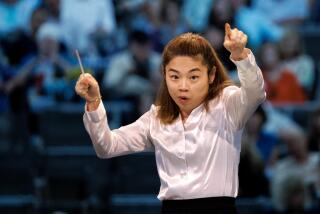Presence with a future
Robert Spano is the former music director of the Brooklyn Philharmonic, where he was venturesome and fairly well liked, and current music director of the Atlanta Symphony, where he is less venturesome and very well liked. He is revered at Tanglewood for his devotion to student conductors and composers. He picked up a couple of Grammys this year for a moderately persuasive recording of Vaughan Williams’ bombastic “A Sea Symphony.” He regularly guest-conducts America’s most important orchestras; sooner or later he will lead one.
Last week Spano stopped by the Walt Disney Concert Hall to conduct the Los Angeles Philharmonic, and at Saturday night’s concert, he was impressive. But it proved to be a program that left as many questions as it answered about this increasingly notable young American conductor.
Spano devoted the evening to a revealing, if cautious, look at American music, of sorts. From 1886 came Edward MacDowell’s Piano Concerto No. 2, music by an American but not with an American voice. At best, there is a hint of a rhythmically bouncy and empty-headed optimistic American accent to a concerto written in the language of Schumann, Grieg and Liszt.
Dvorak’s “New World” Symphony, which ended the program, was composed a few years after the MacDowell concerto as a symphonic lesson from the Old World to the New. The famed Czech composer came to America to teach Americans to write European-style symphonies using American source material such as spirituals and Native American tunes. (MacDowell became an all-too-eager student himself later).
Then there was Copland’s “Symphonic Ode” from 1929 and an example of the early Copland. A modernist work with elements of jazz, it represented a young composer who had just bravely hung up the phone from Europe. Originally Spano was to have conducted Copland’s even more daring and seldom-heard “Connotations,” commissioned for the opening of Lincoln Center’s Philharmonic Hall (now Avery Fisher Hall) in 1962. A courageously strong statement for a glittery occasion, it could have also strengthened Spano’s appearance during the Philharmonic’s first Disney season.
The Ode, though, is still a good piece. Once past its oracular opening, it unleashes an obsessive rhythmic jazziness that is practically proto-minimalist. Its quiet, sparse center is a forerunner of what would come to be associated in Copland with his sense of wonder at the wide Western outdoors. It looks at a vast and exciting America as a land of mystery and industry.
Spano conducted from his muscles, and what we heard was powerful music, powerfully played. There was no mistaking the authority from the podium. The orchestra’s sound was sturdy and Spano never lacked for vigor. But I missed a sense of the score’s flavor, its brittle colors and razor-sharp edges.
MacDowell’s Second Piano Concerto, which followed, is a historical curiosity, and it remains another curiosity why Andre Watts, the evening’s soloist, continues to champion it as he has long done. Well, it’s not a complete curiosity, since the solo part is full of show and Watts is a superb showman. But there are other pieces in which he can demonstrate his sensational elan and say something.
As a model for Americans, Dvorak’s “New World” Symphony can seem cluelessly arrogant, an attempt to civilize the natives. But it has become one of the most popular symphonies in the repertory precisely because it is such a bad model. While inspiring no worthwhile American music (although Ives may have gotten a idea or two from it), it did movingly express the homesickness of a composer, settled for a bit in New York and alert to what he heard around him.
In fact, Dvorak’s personal reaction to the emotions he felt in the music of spirituals resonates profoundly in the “New World,” and in an illuminating pre-concert talk, Michael Steinberg spoke of it as a great tragic work. That was not lost on Spano, although by emphasizing grandeur and momentum, he took what might be called a semi-tragic approach.
In the process, he obtained a satisfyingly full and grounded sound from the Philharmonic, but he never seemed entirely comfortable with the Disney acoustics. Instrumental colors came out muted and the orchestra appeared to hold back, knowing not to overplay in this lively sonic environment. Still, there was enough tense excitement to hold the attention and stimulate a steady flow of adrenaline.
More to Read
The biggest entertainment stories
Get our big stories about Hollywood, film, television, music, arts, culture and more right in your inbox as soon as they publish.
You may occasionally receive promotional content from the Los Angeles Times.











